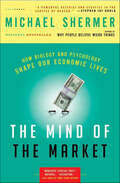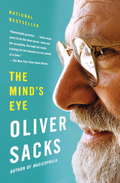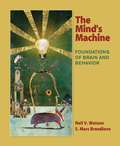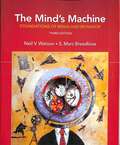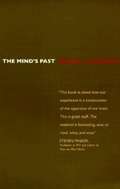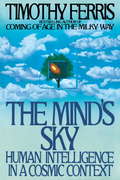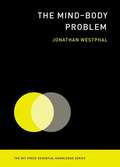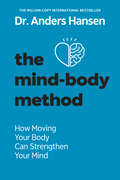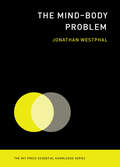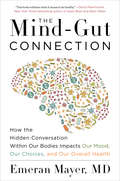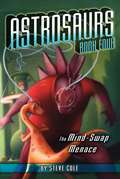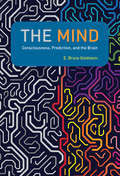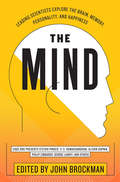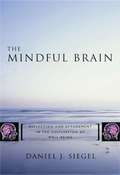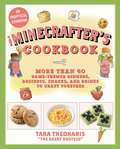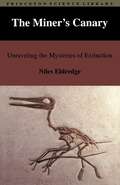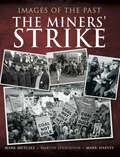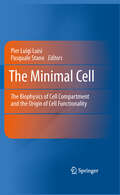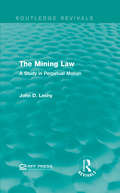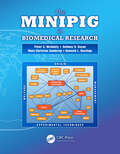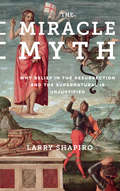- Table View
- List View
The Mind of the Market: How Biology and Psychology Shape Our Economic Lives
by Michael ShermerBestselling author Michael Shermer explains how evolution shaped the modern economy—and why people are so irrational about moneyHow did we make the leap from ancient hunter-gatherers to modern consumers and traders? Why do people get so emotional and irrational about bottom-line financial and business decisions? Is the capitalist marketplace a sort of Darwinian organism, evolved through natural selection as the fittest way to satisfy our needs? In this eye-opening exploration, author and psychologist Michael Shermer uncovers the evolutionary roots of our economic behavior.Drawing on the new field of neuroeconomics, Shermer investigates what brain scans reveal about bargaining, snap purchases, and establishing trust in business. He scrutinizes experiments in behavioral economics to understand why people hang on to losing stocks, why negotiations disintegrate into tit-for-tat disputes, and why money does not make us happy. He brings together astonishing findings from psychology, biology, and other sciences to describe how our tribal ancestry makes us suckers for brands, why researchers believe cooperation unleashes biochemicals similar to those released during sex, why free trade promises to build alliances between nations, and how even capuchin monkeys get indignant if they don't get a fair reward for their work.
The Mind's Eye
by Oliver SacksIn The Mind's Eye, Oliver Sacks tells the stories of people who are able to navigate the world and communicate with others despite losing what many of us consider indispensable senses and abilities: the power of speech, the capacity to recognize faces, the sense of three-dimensional space, the ability to read, the sense of sight. For all of these people, the challenge is to adapt to a radically new way of being in the world. There is Lilian, a concert pianist who becomes unable to read music and is eventually unable even to recognize everyday objects, and Sue, a neurobiologist who has never seen in three dimensions, until she suddenly acquires stereoscopic vision in her fifties. There is Pat, who reinvents herself as a loving grandmother and active member of her community, despite the fact that she has aphasia and cannot utter a sentence, and Howard, a prolific novelist who must find a way to continue his life as a writer even after a stroke destroys his ability to read. And there is Dr. Sacks himself, who tells the story of his own eye cancer and the bizarre and disconcerting effects of losing vision to one side. Sacks explores some very strange paradoxes-- people who can see perfectly well but cannot recognize their own children, and blind people who become hyper-visual or who navigate by tongue vision. He also considers more fundamental questions: How do we see? How do we think? How important is internal imagery or vision, for that matter? Why is it that, although writing is only five thousand years old, humans have a universal, seemingly innate, potential for reading? The Mind's Eye is a testament to the complexity of vision and the brain and to the power of creativity and adaptation. And it provides a whole new perspective on the power of language and communication, as we try to imagine what it is to see with another person's eyes, or another person's mind.
The Mind's Machine: Foundations of Brain and Behavior
by S. Marc Breedlove Neil V. WatsonThe book introduces us to the basics of behavioral neuroscience in a way that focuses on the foundational topics in the field.
The Mind's Machine: Foundations of Brain and Behavior (Sinauer Series)
by S. Marc Breedlove Neil V. WatsonThe Mind's Machine, introduced in 2012, was written to impart the core concepts of behavioral neuroscience to students in a diverse range of disciplines, including not only psychology and the other life sciences, but art, philosophy, media studies, linguistics, and the like. <p><p>Using streamlined text, full color art, novel pedagogical features, and real life examples and analogies, The Mind's Machine, Third Edition, engages students new to neuroscience without sacrificing accuracy. This accessible, reader friendly book is appropriate for brain and behavior, biopsychology, and physiological psychology courses.
The Mind's Past
by Michael S. GazzanigaThis book tackles the puzzling questions of how the brain and mind are connected in brief and entertaining prose. Gazzaniga's discussion of the "interpreter" (a handy internal device that takes perceived experiences recorded by the brain and delivers them to our conscious mind) is truly groundbreaking.
The Mind's Sky: Human Intelligence in a Cosmic Context
by Timothy FerrisThe bestselling author of Coming of Age in the Milky Way brilliantly synthesizes inner and outer space, brain-mind science and SETI in this penetrating examination of the universe.
The Mind--Body Problem
by Jonathan WestphalPhilosophers from Descartes to Kripke have struggled with the glittering prize of modern and contemporary philosophy: the mind-body problem. The brain is physical. If the mind is physical, we cannot see how. If we cannot see how the mind is physical, we cannot see how it can interact with the body. And if the mind is not physical, it cannot interact with the body. Or so it seems. In this book the philosopher Jonathan Westphal examines the mind-body problem in detail, laying out the reasoning behind the solutions that have been offered in the past and presenting his own proposal. The sharp focus on the mind-body problem, a problem that is not about the self, or consciousness, or the soul, or anything other than the mind and the body, helps clarify both problem and solutions. Westphal outlines the history of the mind-body problem, beginning with Descartes. He describes mind-body dualism, which claims that the mind and the body are two different and separate things, nonphysical and physical, and he also examines physicalist theories of mind; antimaterialism, which proposes limits to physicalism and introduces the idea of qualia; and scientific theories of consciousness. Finally, Westphal examines the largely forgotten neutral monist theories of mind and body, held by Ernst Mach, William James, and Bertrand Russell, which attempt neither to extract mind from matter nor to dissolve matter into mind. Westphal proposes his own version of neutral monism. This version is unique among neutral monist theories in offering an account of mind-body interaction.
The Mind-Body Method: How Moving Your Body Can Stop You Losing Your Mind
by Anders HansenINTERNATIONAL BESTSELLER • Over 1 million copies sold! • &“An essential how-to book to reduce stress, calm anxiety, and keep your brain active.&” —Nir Eyal, author of IndistractableDo you want to reduce your stress levels, boost your memory, mood, and focus, and be more creative? Then it&’s time to get moving!In this groundbreaking international bestseller, The Mind-Body Method, acclaimed psychiatrist and mental health guru Dr. Anders Hansen reveals a simple yet effective method for transforming your life: exercise. Dr. Hansen explains the evolutionary reason that exercise can reduce stress and anxiety, boost memory and focus, raise IQ, and even slow down the aging process.Drawing on his vast expertise, Dr. Hansen provides practical and concrete advice on how we can all harness the benefits of daily movement. From understanding why our brains are wired to move to motivating ourselves to achieve our health and fitness goals, The Mind-Body Method offers a life-altering approach to physical and mental well-being. Dr. Hansen is a renowned psychiatrist, well-being guru, and award-winning author whose expertise in the field has earned him international recognition as a two-time winner of the book of the year Big Health Award and Sweden&’s Mensa Prize 2018.Backed by extensive research, data, and studies spanning decades and countries, Dr. Hansen&’s insights are not only scientifically proven, but also enriched and explored through his TV series delving into the intricacies of the human brain, making him a trusted authority in the field of mental health, fitness, and overall well-being.If you&’re ready to transform your mental and physical health and unlock your full potential, The Mind-Body Method is the essential guide you need. Find out the optimal types of exercise and the duration needed to improve your attention span, memory, and overall mood.With over 1 million copies sold, this book has already been translated in 25 languages, transforming the lives of countless readers across cultures and languages.
The Mind-Body Problem (The MIT Press Essential Knowledge Series)
by Jonathan WestphalAn introduction to the mind–body problem, covering all the proposed solutions and offering a powerful new one. Philosophers from Descartes to Kripke have struggled with the glittering prize of modern and contemporary philosophy: the mind-body problem. The brain is physical. If the mind is physical, we cannot see how. If we cannot see how the mind is physical, we cannot see how it can interact with the body. And if the mind is not physical, it cannot interact with the body. Or so it seems.In this book the philosopher Jonathan Westphal examines the mind-body problem in detail, laying out the reasoning behind the solutions that have been offered in the past and presenting his own proposal. The sharp focus on the mind-body problem, a problem that is not about the self, or consciousness, or the soul, or anything other than the mind and the body, helps clarify both problem and solutions. Westphal outlines the history of the mind-body problem, beginning with Descartes. He describes mind-body dualism, which claims that the mind and the body are two different and separate things, nonphysical and physical, and he also examines physicalist theories of mind; antimaterialism, which proposes limits to physicalism and introduces the idea of qualia; and scientific theories of consciousness. Finally, Westphal examines the largely forgotten neutral monist theories of mind and body, held by Ernst Mach, William James, and Bertrand Russell, which attempt neither to extract mind from matter nor to dissolve matter into mind. Westphal proposes his own version of neutral monism. This version is unique among neutral monist theories in offering an account of mind-body interaction.
The Mind-Gut Connection: How the Hidden Conversation Within Our Bodies Impacts Our Mood, Our Choices, and Our Overall Health
by Emeran MayerCutting-edge neuroscience combines with the latest discoveries on the human microbiome to inform this practical guide that proves once and for all the inextricable, biological link between mind and body.We have all experienced the connection between our mind and our gut—the decision we made because it “felt right;” the butterflies in our stomach before a big meeting; the anxious stomach rumbling when we’re stressed out. While the dialogue between the gut and the brain has been recognized by ancient healing traditions, including Aryuvedic and Chinese medicine, Western medicine has failed to appreciate the complexity of how the brain, gut, and more recently, the microbiome—the microorganisms that live inside us—communicate with one another. In The Mind-Gut Connection, Dr. Emeran Mayer, Executive Director of the UCLA Center for Neurobiology of Stress, offers a revolutionary look at this developing science, teaching us how to harness the power of the mind-gut connection to take charge of our health.The Mind-Gut Connection, shows how to keep the communication brain-gut communication clear and balanced to:• Heal the gut by focusing on a plant-based diet• Balance the microbiome by consuming fermented foods and probiotics, fasting, and cutting out sugar and processed foods• Promote weight loss by detoxifying and creating a healthy digestion and maximum nutrient absorption• Boost immunity and prevent the onset of neurological diseases such as Parkinson’s and Alzheimer’s• Generate a happier mindset and reduce fatigue, moodiness, anxiety, and depression• Prevent and heal GI disorders such as leaky gut syndrome; food sensitivities and allergies; and IBS; as well as digestive discomfort such as heartburn and bloating• And much more.Supplemental enhancement PDF accompanies the audiobook.
The Mind-Gut-Immune Connection: Understanding How Food Impacts Our Mind, Our Microbiome, and Our Immunity
by Emeran MayerCutting-edge neuroscience combines with the latest discoveries on the human microbiome to inform this practical guide that proves once and for all the inextricable, biological link between mind and body.We have all experienced the connection between our mind and our gut—the decision we made because it “felt right;” the butterflies in our stomach before a big meeting; the anxious stomach rumbling when we’re stressed out. While the dialogue between the gut and the brain has been recognized by ancient healing traditions, including Aryuvedic and Chinese medicine, Western medicine has failed to appreciate the complexity of how the brain, gut, and more recently, the microbiome—the microorganisms that live inside us—communicate with one another. In The Mind-Gut Connection, Dr. Emeran Mayer, Executive Director of the UCLA Center for Neurobiology of Stress, offers a revolutionary look at this developing science, teaching us how to harness the power of the mind-gut connection to take charge of our health.The Mind-Gut Connection, shows how to keep the communication brain-gut communication clear and balanced to:• Heal the gut by focusing on a plant-based diet• Balance the microbiome by consuming fermented foods and probiotics, fasting, and cutting out sugar and processed foods• Promote weight loss by detoxifying and creating a healthy digestion and maximum nutrient absorption• Boost immunity and prevent the onset of neurological diseases such as Parkinson’s and Alzheimer’s• Generate a happier mindset and reduce fatigue, moodiness, anxiety, and depression• Prevent and heal GI disorders such as leaky gut syndrome; food sensitivities and allergies; and IBS; as well as digestive discomfort such as heartburn and bloating• And much more.Supplemental enhancement PDF accompanies the audiobook.
The Mind-Swap Menace
by Steve Cole Woody FoxSmashing space stations! While on another vital mission, Captain Teggs and his crew nearly crash into an unknown spaceship. But when it spins around, the gaping hole and the mark of the meat-eaters reveal that it's a carnivore space station! What's it doing in the middle of the Vegetarian Sector? Teggs and his chief engineer, Iggy, board the space station to check it out. They soon discover that the only remaining dinosaurs in the ship are also two of the most evil criminals in the universe, and one of them is a genius. He's built a machine that can swap minds, and he's going to use it on Teggs and Iggy so he and his partner can fulfill their dreams of riches! It's up to Teggs and his crew to stop them, but how can they when no one knows who is who?
The Mind-Swap Menace
by Steve Cole Woody FoxSmashing space stations! While on another vital mission, Captain Teggs and his crew nearly crash into an unknown spaceship. But when it spins around, the gaping hole and the mark of the meat-eaters reveal that it's a carnivore space station! What's it doing in the middle of the Vegetarian Sector? Teggs and his chief engineer, Iggy, board the space station to check it out. They soon discover that the only remaining dinosaurs in the ship are also two of the most evil criminals in the universe, and one of them is a genius. He's built a machine that can swap minds, and he's going to use it on Teggs and Iggy so he and his partner can fulfill their dreams of riches! It's up to Teggs and his crew to stop them, but how can they when no one knows who is who?
The Mind: Consciousness, Prediction, and the Brain
by E. Bruce GoldsteinAn accessible and engaging account of the mind and its connection to the brain.The mind encompasses everything we experience, and these experiences are created by the brain--often without our awareness. Experience is private; we can't know the minds of others. But we also don't know what is happening in our own minds. In this book, E. Bruce Goldstein offers an accessible and engaging account of the mind and its connection to the brain. He takes as his starting point two central questions--what is the mind? and what is consciousness?--and leads readers through topics that range from conceptions of the mind in popular culture to the wiring system of the brain. Throughout, he draws on the latest research, explaining its significance and relevance.
The Mind: Science Tool Kit for the Mind
by John BrockmanWho am "I"? How is happiness achieved? What is the key to memory? How do babies become adults? Is personality determined? What function do emotions serve? Are we hardwired to be moral? The mind is a riddle that has vexed philosophers, psychologists, biologists, and artists for thousands of years. In this invaluable volume, John Brockman, editor and publisher of Edge, gathers the world's most influential scientists and thinkers to present their deepest thoughts and cutting-edge theories in short, accessible essays about the essential aspects of human consciousness and the complex workings of the brain. Contributors and topics include Steven Pinker on how the human brain works Martin Seligman on happiness and what it means to live a good life Philip Zimbardo on the impact of environment on personality V. S. Ramachandran on the question of self-who "you" are Simon Baron-Cohen on the innate differences between boys and girls George Lakoff on the role of the body and brain on different types of reasoning Alison Gopnik on why human children are the best learning machines in the universe Jonathan Haidt on the connection between emotions, morality, and religious belief
The Mindful Brain: Reflection and Attunement in the Cultivation of Well-Being (Norton Series on Interpersonal Neurobiology)
by Daniel J. SiegelA new framework for maintaining mental health and well-being. From the author of the internationally-acclaimed best-selling text The Developing Mind, and esteemed leader and educator in the field of mental health, comes the first book ever to integrate neuroscience research with the ancient art of mindfulness. The result is a groundbreaking approach to not simply mental health, but life in general, which shows readers how personal awareness and attunement can actually stimulate emotional circuits in the brain, leading to a host of physiological benefits, including greater well-being, resilience, emotional balance, and improved cardiac and immune function. For clinicians and laypeople alike, Siegel's illuminating discussions of the power of the focused mind provide a wealth of ideas that can transform our lives and deepen our connections with others, and with ourselves.
The Minecrafter's Cookbook: More Than 40 Game-Themed Dinners, Desserts, Snacks, and Drinks to Craft Together
by Tara TheoharisThe Minecrafter's Cookbook brings the Overworld to life with over 40 fantastic, Minecraft-themed recipes that kids and parents can make together. From main courses that will fill your hunger bar; to enchanted snacks that Alex and Steve couldn’t survive without; to party-friendly, game-themed desserts and potion drinks, there is plenty in this book to enchant young gamers and their families. Kids will love the accompanying illustrations of their favorite characters and scenes, while parents will appreciate the simple, step-by-step directions to guide them as they craft. The Minecrafter's Cookbook makes cooking an irresistible adventure: Includes photos of each finished item, plus colorful illustrations of popular Minecrafting scenes and characters for maximum fun. Features over 40 kid-friendly meals, drinks, and desserts including Beetroot Stew, Golden Apples, Grass Block Brownies, and Creeper Crispies! Encourages young gamers to power down and enjoy family time in the kitchen The delicious recipes in this book are sure to make spending time together a whole lot more fun!
The Miner's Canary: Unraveling the Mysteries of Extinction (Princeton Science Library #13)
by Niles EldredgeLike the bird whose death signaled dangerous conditions in a mine, the demise of animals that once flourished should give humans pause. How is our fate linked to the earth's creatures, and the cycle of flourishing and extinction? Which are the simple workings of nature's order, and which are omens of ecological disaster? Does human activity accelerate extinction? What really causes it? In an illuminating and elegantly written account of the widespread reduction of the world's wildlife, renowned paleontologist Niles Eldredge poses these questions and examines humankind's role in the larger life cycles of the earth, composing a provocative general theory of extinction.
The Miners' Strike: Miners' Strike (Images of the Past)
by Mark Harvey Mark Metcalf Martin JenkinsonIn addition to being the most bitter industrial dispute the coalminers' strike of 1984/5 was the longest national strike in British history. For a year over 100,000 members of the National Union of Mineworkers, their families and supporters, in hundreds of communities, battled to prevent the decimation of the coal industry on which their livelihoods and communities depended. Margaret Thatcher's government aimed to smash the most militant section of the British working class. She wanted to usher in a new era of greater management control at work and pave the way for a radical refashioning of society in favour of neo-liberal objectives that three decades later have crippled the world economy.Victory required draconian restrictions on picketing and the development of a militarised national police force that made widespread arrests as part of its criminalisation policy. The attacks on the miners also involved the use of the courts and anti-trade union laws, restrictions on welfare benefits, the secret financing by industrialists of working miners and the involvement of the security services. All of which was supported by a compliant mass media but resisted by the collective courage of miners and mining communities in which the role of Women against Pit Closures in combating poverty and starvation was heroic. Thus inspired by the struggle for jobs and communities an unparalleled movement of support groups right across Britain and in other parts of the world was born and helped bring about a situation where the miners long struggle came close on occasions to winning.At the heart of the conflict was the Yorkshire region, where even at the end in March 1985, 83 per cent of 56,000 miners were still out on strike. The official Yorkshire National Union of Mineworkers (NUM) area photographer in 1984-85 was the late Martin Jenkinson and this book of his photographs some never previously seen before - serves as a unique social document on the dispute that changed the face of Britain.As featured in The Yorkshire Times, Sheffield Telegraph and NUJ News Leeds.
The Minimal Cell
by Pier Luigi Luisi Pasquale StanoIn the last ten years there has been a considerable increase of interest on the notion of the minimal cell. With this term we usually mean a cell-like structure containing the minimal and sufficient number of components to be defined as alive, or at least capable of displaying some of the fundamental functions of a living cell. In fact, when we look at extant living cells we realize that thousands of molecules are organized spatially and functionally in order to realize what we call cellular life. This fact elicits the question whether such huge complexity is a necessary condition for life, or a simpler molecular system can also be defined as alive. Obviously, the concept of minimal cell encompasses entire families of cells, from totally synthetic cells, to semi-synthetic ones, to primitive cell models, to simple biomimetic cellular systems. Typically, in the experimental approach to the construction of minimal the main ingredient is the compartment. Lipid vesicles (liposomes) are used to host simple and complex molecular transformations, from single or multiple enzymic reactions, to polymerase chain reactions, to gene expression. Today this research is seen as part of the broader scenario of synthetic biology but it is rooted in origins of life studies, because the construction of a minimal cell might provide biophysical insights into the origins of primitive cells, and the emergence of life on earth. The volume provides an overview of physical, biochemical and functional studies on minimal cells, with emphasis to experimental approaches. 15 International experts report on their innovative contributions to the construction of minimal cells.
The Minimalist Program
by Fahad Rashed Al-MutairiThe development of the Minimalist Program (MP), Noam Chomsky's most recent generative model of linguistics, has been highly influential over the last twenty years. It has had significant implications not only for the conduct of linguistic analysis itself, but also for our understanding of the status of linguistics as a science. The reflections and analyses in this book contain insights into the strengths and the weaknesses of the MP. Among these are, a clarification of the content of the Strong Minimalist Thesis (SMT); a synthesis of Chomsky's linguistic and interdisciplinary discourses; and an analysis of the notion of optimal computation from conceptual, empirical and philosophical perspectives. This book will encourage graduate students and researchers in linguistics to reflect on the foundations of their discipline, and the interdisciplinary nature of the topics explored will appeal to those studying biolinguistics, neurolinguistics, the philosophy of language and other related disciplines.
The Mining Law: A Study in Perpetual Motion (Routledge Revivals)
by John D. LeshyOriginally published in 1987, John D. Leshy presents this scholarly study of the 1872 Mining Law as a legal treatise and history of mining in the West from the point of view of mineral exploration and production. This mining law governed the United States mining practice yet had never been changed. The Mining Law attempts to highlight the role of policy and government as well as the more obscure elements of the law which complicated mining practice in the eighties. This title will be of interest to students of Environmental Studies and policy makers.
The Minipig in Biomedical Research
by Kenneth L. Hastings Anthony D. Dayan Peter A. McAnulty Niels-Christian GanderupThe Minipig in Biomedical Research is a comprehensive resource for research scientists on the potential and use of the minipig in basic and applied biomedical research, and the development of drugs and chemicals. Written by acknowledged experts in the field, and drawing on the authors' global contacts and experience with regulatory authorities and
The Miracle Myth: Why Belief in the Resurrection and the Supernatural Is Unjustified
by Larry ShapiroThere are many who believe Moses parted the Red Sea and Jesus came back from the dead. Others are certain that exorcisms occur, ghosts haunt attics, and the blessed can cure the terminally ill. Though extraordinarily improbable, people have embraced miracles and myths for millennia, seeing in them proof of the extraordinary potential of our world-and ourselves.Helping us think more critically about our belief in the improbable, The Miracle Myth breaks down our mythmaking strategies to better understand how attempts to justify belief in the supernatural fall short. Through arguments and accessible analysis, Larry Shapiro sharpens our critical faculties so we become less susceptible to tales of myths and miracles and learn how, ultimately, our belief in them is counterproductive. Shapiro acknowledges that myths have value. They may even provide insight into our place in nature. Even so, if our understanding of reality is formed through the fallacy of myth, our ties to the world fray. Shapiro's investigation reminds us of the importance of evidence and rational thinking as we explore the unknown.
The Miracle Myth: Why Belief in the Resurrection and the Supernatural Is Unjustified
by Lawrence ShapiroThere are many who believe Moses parted the Red Sea and Jesus came back from the dead. Others are certain that exorcisms occur, ghosts haunt attics, and the blessed can cure the terminally ill. Though miracles are immensely improbable, people have embraced them for millennia, seeing in them proof of a supernatural world that resists scientific explanation.Helping us to think more critically about our belief in the improbable, The Miracle Myth casts a skeptical eye on attempts to justify belief in the supernatural, laying bare the fallacies that such attempts commit. Through arguments and accessible analysis, Larry Shapiro sharpens our critical faculties so we become less susceptible to tales of myths and miracles and learn how, ultimately, to evaluate claims regarding vastly improbable events on our own. Shapiro acknowledges that belief in miracles could be harmless, but cautions against allowing such beliefs to guide how we live our lives. His investigation reminds us of the importance of evidence and rational thinking as we explore the unknown.
